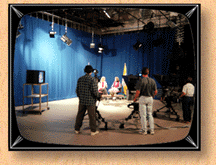

1. Avoid rolling rigor mortis by using heads
and tripods made for
motion media. Tripods and heads designed for still
photography work
poorly for video. Although the heads can be aimed
anywhere, they
cannot move smoothly enough for gentle tilts and
pans. Also, the
tripods at the end of a pan tend to "unwind"
causing your panned image
to back up a little ways.
2. If the camera is fairly heavy, or will be used by students,
and
will be used in a studio setting, employ a cam-link
or cradle head.
If a student lets go of a camera without tightening the tilt controls,
the camera can nosedive forward breaking the lens
or even toppling the
tripod. Cam-link and cradle heads have a stable
center of gravity
swinging the camera to a horizontal position when
the controls are
loose. (In order to work, however, the camera,
teleprompter, and
other camera gadgets must be positioned properly
for good balance).
3. When working in the field use a fluid or fluid-like
head. Tripod
heads like the O'Connor and Miller fluid heads
contain a viscous oil
which dampens movement making camera moves smooth.
When using
a true fluid head, be sure to work the
head back and forth a few times to
"loosen up" the fluid. Fluid-like heads
are less expensive and
simulate the fluid effect by employing a thick
grease in the
mechanism. Fluid-like heads work almost as well
as their brothers but
get stiff in cold weather (don't we all).
4. Use a ball, wedge or other quick-disconnect
mount if your camera
needs to attach and detach from your tripod frequently.
A wedge
mount, for instance, screws onto the base of your
camera while its
mate screws onto the tripod head. To attach the
camera to the head,
simply slide the plate into the slot until it
clicks; you'll have a
solid connection. Push one button and the camera
and its mount slide
free of the head, a much easier process than spinning
little nuts and
tightener rings under the camera (a real pain
in the wrist).
5. If you set up the tripod often, invest in telescoping
legs with
levers, not collars. Usually these legs are square.
Press the lever,
pull the leg, and out it comes. This is much easier
than twisting
tightening collars (another pain in the wrist),
and sometimes those
collars work themselves loose allowing your tripod
to tumble.
6. When using telescoping tripod legs, telescope
the fat legs first
and work your way out to the skinny legs. This
will create a more
sturdy tripod on occasions when the legs aren't
fully extended.
7. For sports and other pick-up-and-go situations,
try a monopod, a
one-legged tripod. It steadies your picture, takes
the camera's
weight off your arms (a real blessing about 1/2
hour into a sporting
event), packs down to the size of an umbrella,
and transports quickly,
even in a crowd. You can even use a monopod as
a boom to lift your
camera over the heads of others or to catch a
bird's eye or
over-the-cliff view.
8. Dollies are useful on smooth floors only. Small
castors seem to
amplify imperfections in the floor's surface,
so buy a dolly with the
biggest diameter castors you can get. Most dollies
come in the shape
of the letter "Y" with a wheel at each
end, and can fold up for
storage and transportation. Most allow the wheels
to lock, keeping
your dolly from careening down inclines, and a
few allow the wheels to
be locked in one direction, allowing you to dolly
the camera in, then
back up directly, without traversing a little
loop as the castors
change position. Larger dollies even have cableguards
to sweep away
mike and camera cables that would give your image
that bumpity bump
look.
9. You'll always need a tripod, but if you tape
a lot of travelling
shots, have you thought of renting a $40,000 Steadicam,
or its $12,500
little brother Steadicam Video VX, or buying its
$595 baby sibling,
the Steadicam JR (all from Cinema Products)? A
newcomer to the field
is the Bodycam (Continental Camera Systems), sort
of a crane that
straps to your back and reaches over your shoulder
to steady the
camera while you run or pivot. On the other hand,
you could let the
camera shake but keep the lens steady with a Schwem
Gyrozoom image
stabilizing lens, or by using a camcorder with
EIS (Electric Image
Stabilization). These systems actually work, and
are a lot easier to
carry through the jungle than a tripod.
10. Let creativity be your dolly. A small camcorder
fits nicely into
a model railroad car for a smooth rail ride through
the garden.
Shopping carts (not the ones with square wheels) will move camera
and
operator through corridors and parking lots. So
will wheelchairs.
Carpeting makes a nice sled over a polished floor.
<
| About the author | About Today's Video 4th. ed. | Return home |